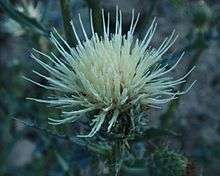Cirsium cymosum
| Cirsium cymosum | |
|---|---|
 | |
| Scientific classification | |
| Kingdom: | Plantae |
| (unranked): | Angiosperms |
| (unranked): | Eudicots |
| (unranked): | Asterids |
| Order: | Asterales |
| Family: | Asteraceae |
| Tribe: | Cynareae |
| Genus: | Cirsium |
| Species: | C. cymosum |
| Binomial name | |
| Cirsium cymosum (Greene) J.T.Howell | |
| Synonyms[1] | |
| |
Cirsium cymosum is a North American species of thistle known by the common name peregrine thistle. It is native to the western United States, where it has been found in California, Oregon, Nevada, Utah, Idaho, Wyoming, and Montana.[2][3]
Cirsium cymosum is a biennial or perennial herb with a maximum height just 100 cm (39 in). It is coated in soft and coarse hairs and sometimes cobwebby fibers. The spiny leaves may reach 30 to 50 centimeters (12 to 20 inches) in length, especially toward the base of the stem. They are deeply cut into lobes which are lined with sharp teeth. The inflorescence is a cluster of flower heads each up to 3 centimeters long and 5 wide. The head is lined with sticky, spiny phyllaries and filled with dull white flowers. The fruit is an achene with a dark-colored body just under a centimeter long and a pappus of hairs up to 2.5 centimetres (0.98 inches) in length.[4]
- Cirsium cymosum var. canovirens (Rydb.) D.J.Keil - most of species range[5]
- Cirsium cymosum var. cymosum - California, Nevada, Oregon
References
- 1 2 The Plant List, Cirsium cymosum
- ↑ Biota of North America Program 2014 county distribution map
- ↑ Calflora taxon report, University of California, Cirsium cymosum (E. Greene) J. Howell, peregrine thistle
- 1 2 Flora of North America, Cirsium cymosum (Greene) J. T. Howell
- ↑ Flora of North America: var. canovirens
External links
- Jepson Manual Treatment
- United States Department of Agriculture Plants Profile
- Calphotos Photo gallery, University of California